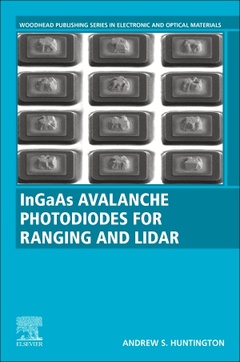InGaAs Avalanche Photodiodes for Ranging and Lidar Woodhead Publishing Series in Electronic and Optical Materials Series

InGaAs Avalanche Photodiodes for Ranging and Lidar discusses the materials, physics, and design considerations of avalanche photodiodes (APDs) developed for 3D imaging sensors, which will enable self-driving cars and autonomously navigating drones.
The book provides a detailed theoretical understanding of all types of APD, including the semiconductor physics underlying device function and the mathematics of avalanche noise. Both linear- and Geiger-mode operation of APDs are addressed, and contemporary research on APDs manufactured from a variety of different material systems is reviewed. The approach unites a theoretical treatment of common figures of merit with a practical discussion of how they impact sensor system performance. Models are developed for the sensitivity, maximum effective range, and ranging precision of time-of-flight APD photoreceiver circuits.
Linear-mode InGaAs APDs are of particular relevance to 3D imaging owing to their compatibility with eye-safe lasers, and the maturity of the material system, for which substantial commercial foundry capacity exists. The author uses InGaAs APDs to demonstrate the book?s design calculations, which are compared to the representative empirical data, and as the basis for discussions of device structure and manufacturing.
r1. Types of avalanche photodiode 2. Avalanche photodiode figures of merit 3. APD photoreceivers for range-finding and lidar 4. Linear-mode InGaAs APD design and manufacture Appendix: Semiconductor physics
: Materials Scientists and Engineers, Electrical Engineers, researchers, scientists and engineers working in R&D
Prior to joining Voxtel, Dr. Huntington performed his doctoral studies in materials at the University of California, Santa Barbara (L. Coldren Group), where his dissertation work included development of low-noise and broad-area InGaAs/InAlAs APDs. Dr. Huntington developed his expertise in the production of APD wafers by molecular beam epitaxy, with particular emphasis on understanding the relationship between growth conditions, material quality, and device performance.
- Addresses the materials, device and system design challenges that face researchers today, presenting all the information in one key resource
- Reviews all key APD figures of merit and explains the connection between device and system performance
- Written by an industry expert with 13 years of experience developing InAlAs, InGaAs and InP avalanche photodiodes (APDs)
Date de parution : 05-2020
Ouvrage de 400 p.
15x22.8 cm
Mots-clés :
APD; APD design; avalanche photodiode; band gap; breakdown probability; dead space multiplication theory; density of states; DSMT; effective mass; effective range; excess noise; figure of merit; Geiger mode; generation-recombination; impact ionization; impulse response; lidar; linear mode; multiplication noise; NEP; noise; optical absorption; photoreceiver; range error; range-finding; semiconductor band structure; sensitivity; simulation; SNR; SPAD; SRH; timing error; timing jitter; TMM; transfer matrix method; tunneling



